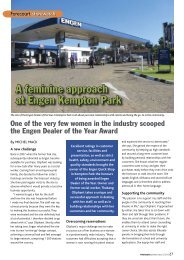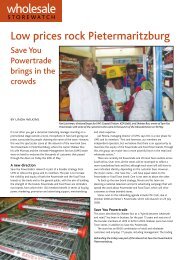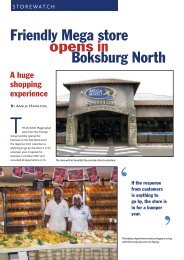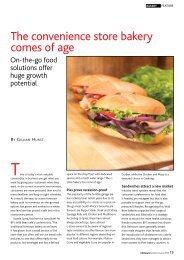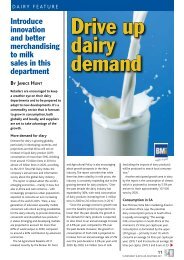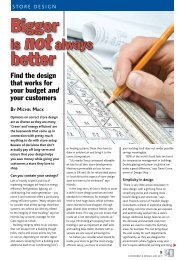Refrigeration - Supermarket.co.za
Refrigeration - Supermarket.co.za
Refrigeration - Supermarket.co.za
You also want an ePaper? Increase the reach of your titles
YUMPU automatically turns print PDFs into web optimized ePapers that Google loves.
Self-<strong>co</strong>ntained versus remote<br />
refrigeration cabinets<br />
Debates between remote and self-<strong>co</strong>ntained (or plug-in) cabinets<br />
have raged for decades but the decision is ultimately based on <strong>co</strong>st,<br />
capacity and efficiency.<br />
Nic Visser, MD of AHT Africa says the benefits of plug-in<br />
cabinets are numerous. Firstly, there is the capital <strong>co</strong>st saving, as<br />
well as building <strong>co</strong>st savings in landlord <strong>co</strong>sts because no drains<br />
or trenches, or even a plant room are required. Plug-in cabinets<br />
also have flexibility on their side as they can be moved any time<br />
in-store. “There is also reduced installation time on site, resulting<br />
in earlier opening dates so the turnover is realised sooner against<br />
investment,” he says.<br />
However, there are also disadvantages with plug-in cabinets.<br />
The cabinets tend to <strong>co</strong>nsume more energy than remote ones,<br />
increasing the in-store heating and as a result, air-<strong>co</strong>nditioning<br />
requirements increase too. Plug-in cabinets also emit more noise<br />
pollution and volume capacity for merchandise is generally lower<br />
than remote cabinets. Although Visser does point out the AHT<br />
cabinets have a lower energy <strong>co</strong>nsumption rate than most, as well<br />
as a greater capacity than most remote ones.<br />
IMPULSE MERCHANDISERS<br />
Many retailers are looking for <strong>co</strong>mpact narrow displays that optimise<br />
the expensive retail space and reduce rentals. Compact displays reduce<br />
the amount of display space but this helps to reduce wastage of food<br />
product not sold.<br />
The right light<br />
Introducing LED lighting can offer up to 15% in electrical savings,<br />
ac<strong>co</strong>rding to The Fridge Factory’s Roy Singh. “LEDs emit less harmful<br />
UV light so products last longer and the lighting is 50% brighter<br />
than a standard fluorescent tube,” he says. Fluorescent tubes also<br />
<strong>co</strong>ntain mercury, the environmental harm of which is permanent,<br />
which means that the glass cannot be recycled.<br />
“LED’s use significantly less power than traditional light sources,<br />
has a low power <strong>co</strong>nsumption and heat emission, as well as a low<br />
maintenance <strong>co</strong>st,” explains Just <strong>Refrigeration</strong>’s David Earle. He<br />
adds that there is a direct <strong>co</strong>rrelation between the LED product’s<br />
ability to dissipate heat and the lifespan of the LED. Also, a high<br />
quality LED product still needs to be fitted <strong>co</strong>rrectly.<br />
Exceeding maximum draw<br />
No retailer wants to exceed maximum draw at any time as this<br />
results in heavy penalties to be paid to the local municipality. There<br />
are various ways to ensure that this does not happen. Firstly, the<br />
15<br />
SUPERMARKET & RETAILER, MAY 2011<br />
▲<br />
AVAILABLE SIZES<br />
1300/2000 WIDE<br />
AVAILABLE SIZES<br />
MODERNISE<br />
YOUR<br />
IMAGE



